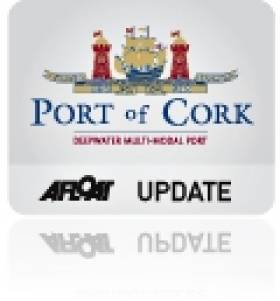Displaying items by tag: Irish Harbours
€35m Brexit Infrastructure Fund to Support Coastal Communities Announced
Marine Minister Charlie McConalogue T.D., has announced a new €35m scheme to rejuvenate local authority public piers and harbours throughout coastal communities. The record funded scheme is proposed for funding under the EU Brexit Adjustment Reserve (BAR) and was one of the recommendations of the Seafood Sector Taskforce which was established by the Minister following Brexit.
Announcing the scheme, the Minister said “This record funding for our coastal communities is an unprecedented opportunity for us to invest in our publicly owned piers and harbours and will shape the future of our coastal communities. Brexit has and will continue to affect our seafood sector in a unique way compared to other industries. I am delighted to be able to offer this level of investment so that we can deliver safe, accessible, lasting infrastructure and support economic diversification right around our coastline.”
In the wake of the outcome of the Trade and Cooperation Agreement between the European Union and the United Kingdom (TCA), Minister McConalogue set up the Seafood Taskforce in March 2021 to look at the impacts specifically on the fishing sector and coastal communities. In its report, published last October, the Taskforce noted that many coastal structures, which are both important landmarks and facilities to the local communities, have declined in structural integrity and effective use over the years. As one of its recommendations, the Seafood Taskforce recommended that the BAR be used to fund the rejuvenation of Ireland’s publicly owned coastal and marine infrastructure specifically to address the economic consequences of Brexit arising from the implications to the Irish fishing industry. This investment is intended to help to drive economic diversification and will complement other measures such as Community-Led Local Development via the Fisheries Local Action Groups.
The investment scheme focuses on ‘shovel-ready’ projects to give immediate construction stimulus to the coastal communities affected by the TCA and is targeted to attract such projects of up to €1m budget during 2022 and 2023. The Scheme also offers the possibility of funding larger projects where there is particular exposure to Brexit due to proximity to UK waters and loss of fishing opportunities. The projects will be delivered by the local authority which owns and maintains the relevant marine infrastructure.
The Minister encouraged local authorities to make full use of this unique opportunity: “So much of the outcome of Brexit has been bad news for local coastal communities. Now we have this opportunity to support economic growth and mitigate the negative impacts for these communities. Ireland has fought hard for a fair BAR allocation; now we must put it to good use.”
The Department of Agriculture, Food and the Marine will administer the Scheme and work closely with coastal local authorities to ensure that eligible projects receive funding.
Local Authority Harbours To Benefit From €4.5m Capital Programme
#IrishHarbours - Marine Minister Simon Coveney has announced details of a €4.5 million package to assist in the development and repair of 90 Local Authority-owned harbours and slipways.
The package provides funding for the repair of piers damaged by recent storms, in addition to supporting the ongoing development and enhancement of harbour facilities including some marine leisure developments.
“This is a significant investment in the repair and development of fishery and aquaculture linked marine infrastructures owned by the Local Authorities,” said the minister upon the announcement last Friday (19 February).
The Local Authority programme forms part of the Department of Agriculture, Food and the Marines’ 2016 Fishery Harbour and Coastal Infrastructure Development Programme, whereby the department co-funds up to 75% the total cost of approved projects with the Local Authority providing the balance.
Last month, Ireland's fishery harbours were announced as beneficiaries of €18 million worth of capital investment under the programme, as previously reported on Afloat.ie.
“The 90 Local Authority owned harbours in receipt of funding this year play an important social and economic role in their respective localities by contributing to the ongoing development of fishing-related activities, increasing participation in marine leisure, and augmenting measures to attract greater numbers of tourists which ultimately create the environment for job creation,” said Minister Coveney. “This is a major contribution to the social and economic fabric of these coastal communities and underlines this Government's commitment to rural development.
"The diverse range of projects approved for funding under the programme are geographically spread across 11 Local Authorities which will not only create much needed local employment over the timespan of the projects, but equally will further enhance the amenities provided to the wider marine community in these coastal areas.”
See the full table of Local Authority harbour works and grants for 2016 attached below.
Deadline Nears For Submissions On Dun Laoghaire Draft Development Plan
#DunLaoghaire – Users of Dun Laoghaire Harbour can make submissions in support of the proposed amendments to the draft Dun Laoghaire-Rathdown County Council (DLRCoCo) Development Plan 2016-2022 before the closing date of 5pm on Tuesday 22 December.
Campaigners against the proposed cruise liner terminal for the harbour, the oral hearings on which recently concluded, have identified five amendments and policies that require public support. These are:
- Amendment to SECTION 4: GREEN COUNTY STRATEGY that introduces additional Policy and Section, after Section 4.2.2.11 as follows: Section 4.2.2.12 Policy OSR13 (To protect Dún Laoghaire as an Outstanding Recreational Harbour and Sporting Amenity of National Significance): “It is Council policy to protect and enhance the water based recreational amenity of Dun Laoghaire Harbour and its ability to host national and international competitions. Any commercial shipping proposals within the Harbour should be required to ensure that there is no material detrimental impact upon the water based recreational amenity facilities of the Harbour and its ability to host national and international competitions.”
- Amendment to SECTION 9: SPECIFIC LOCAL OBJECTIVES to Amend SLO No. 13 as follows: “To facilitate the continued development of the Harbour, ensuring at all times that the historic significance and natural beauty of this public amenity is protected, in advance of the preparation of the Dún Laoghaire and Environs Local Area Plan (LAP). Following the adoption of the Dún Laoghaire and Environs LAP, the future development of the Harbour will thereafter be guided by the principles and objectives of the Plan and that of Policy E14.”
- Amendment to SECTION 9:SPECIFIC LOCAL OBJECTIVES to Insert additional SLO No. 156 as follows: “In accordance with the National Ports Policy the Council shall, within the relevant planning frameworks, formulate and implement, where appropriate and applicable, a plan for the future development of Dún Laoghaire Harbour and its curtilage as determined by Part 1, subsection 6 of the Third Schedule of the Harbours Act, 1996.”
- Amendment to SECTION 9: SPECIFIC LOCAL OBJECTIVES to Insert additional SLO No. 157 as follows: “To support and encourage the development of a National Watersports Centre to facilitate training and participation in a varied range of water sports and activities to provide a focus for national and international watersport events. Site appraisal and analysis of the harbour environs to identify the optimum location(s) for such a centre to be expedited as an integral component of the forthcoming Dún Laoghaire and environs LAP.”
- Amendment to APPENDIX 12: DÚN LAOGHAIRE URBAN FRAMEWORK PLAN Section 3.2.1 Central Harbour Area to add new first sentence to the first paragraph of this section as follows: “It will be an objective of this Plan to preserve the integrity, natural beauty and historical significance of the Harbour by protecting this central area from any cruise berth that would allow cruise ships longer than 250m to come directly into the harbour. This plan will support and encourage the niche market of smaller cruise ships."
Submissions can be made by three ways: via email, via letter or by consultation on the DLRCoCo website.
Emails to [email protected] should be sent with the subject subject line 'Submission on Proposed Amendments to Draft County Development Plan 2016 - 2022'. The text of the email/letter should include your name, your address and the following text:
I wish to support the following amendments to the Draft County Development Plan 2016-2022
1. Section 4: GREEN COUNTY STRATEGY
To lntroduce additional Policy and Section, after Section 4.2.2.ll as follows:
Section 4.2.2.12 Policy OSR 13
To protect Dun Laoghalre as an Outstanding Recreational Harbour and Sporting Amenity of National Significance.
2. SECTION 9: SPECIFIC LOCAL OBJECTIVES
To amend SLO No. 13
To insert additional SLO No. 156
To insert additional SLO No. 157
3 APPENDIX 12: DUN LAOGHAIRE URBAN FRAMEWORK PLAN
Section 3.2.1 Central Harbour Area.
To add a new first sentence to the first paragraph of this section
Letters should be addressed to:
Senior Executive Officer,
Planning & Organisational Innovation Department,
Dun Laoghaire-Rathdown County Council,
County Hall,
Marine Road,
Dun Laoghaire
Silt Renders Low-Water Launches 'Impossible' At Howth Harbour
#IrishHarbours - Concerns over rising silt levels in Howth Harbour have made the pages of the Swords Gazette, which quotes the Harbour Users Action Group as saying launches at low water on a spring tide are now impossible.
Not only is the harbour's busy fishing industry under threat, but coastguard and lifeboat rescues – the harbour is home to Howth RNLI – could also be affected.
"The potential for that is very serious," said the group's Brian Turvey, who claims that various Governments have passed the buck for responsibility since the harbour was last dredged in the early 1980s.
"We've got to the stage now where we have about a metre and a half of silt accumulated," he added, noting the problems that poses for boats with deeper keels.
His comments echo a recent statement by local TD Tommy Broughan, who said it is "critical that the harbour does not become unworkable as a result of the build-up of silt".
Trawling For Sprat In Dun Laoghaire's Inner Harbour Surprises Locals
#IrishHarbours - Concerns expressed by a number of readers to Afloat.ie over fishing activity in Dun Laoghaire's inner harbour have been assuaged by the Dun Laoghaire Harbour Company.
Two trawlers were spotted around noon last Friday (4 December) dragging a full-sized fishing net between them around the inner harbour.
But Dun Laoghaire's acting harbour master Simon Coate has since confirmed to Afloat.ie that the boats in question were fishing with permission for sprat.
Coate added that the forage fish species comes into the harbour in large numbers on a regular basis at this time of year.
Harbour concerns of a different kind have been heard in Howth, with local TD Tommy Broughan taking the Department of the Marine to task over the lack of any timetable or specific funding for dredging the harbour area - where local yacht club users have found conditions getting worse.
In a post on his website, Deputy Broughan said he was "contacted by members of the Howth Harbour Users Action Group who are very concerned about the build-up of silt in the harbour and the damaging effect this is having on all aspects of this important harbour.
"Howth Harbour has not been dredged for decades. I understand it was last dredged in 1981 or 1982 and I do not recall a dredging programme in the harbour in many years representing the area.
"The action group reports that this neglect has led to almost 6ft of silt building up in the harbour and an operational crisis for all the fishing and leisure craft which use it."
While welcoming investment in infrastructural works at the fishery harbour centre, Deputy Broughan underlines that it is "critical that the harbour does not become unworkable as a result of the build-up of silt".
Read more on this story HERE.
Syrian Refugees To Be Housed In Irish Harbour?
#DunLaoghaire - Housing refugees from Syria on a ship anchored in an Irish harbour is among the proposals submitted to the State's tender for emergency accommodation.
According to RTÉ News, plans are in the offing to set up a network of 'Emergency Reception and Orientation Centres' to accommodate refugees fleeing the humanitarian crisis in the Middle East.
And as the Sunday Business Post reports, one proposal submitted under the call for tender for this plan comes from a shipping magnate who would house hundreds of refugees on a ship in an Irish harbour.
Among the most likely locations is Dun Laoghaire – where plans for a next-generation cruise liner terminal have united local residents, politicians and business leaders in opposition.
The emergency reception proposals have been themselves been criticised by migrant rights groups for their similarity to the controversial direct provision centres for asylum seekers.
#DunmoreEast - Marine Minister Simon Coveney is set to attend the opening of Dunmore East's new harbour slipway this coming Wednesday 30 April.
The minister will visit the harbour area between 5pm and 6pm to open the slipway as well as announce the dredging of the harbour - funded under the State's €23m package for marine infrastructure repairs announced last month - and the commencement of works on a new harbour building.
Following the harbour visit, the first session of a two-day seminar on 'Empowering Coastal Communities' will take place at the Haven Hotel, with a keynote from Seán Kelly MEP and much interest among the local sailing community.
The seminar, hosted by the Waterford Estuary Communities Network, will continue on 1 May with sessions in Waterford and Hook Head featuring speakers such Afloat's own Tom McSweeney.
WM Nixon has more on the ambitious plans for the Waterford sailing and fisheries hub in his most recent Sailing Saturday column HERE.
Sandycove Harbour Gets Funding Boost in Budget '14 Allocation
#Harbours - Sandycove Harbour will receive more than €50,000 from a €295,000 package for repairs and upgrades to piers, quays and harbours around the Irish coast, as South County Dublin LifeTimes reports.
The funding forms part of the €10 million allocation in last month's Budget to maintain the infrastructure of the State's fishery harbours, as previously announced by Marine Minister Simon Coveney.
Covering 75% of the anticipated €70,000 cost of remedial works at Sandycove Harbour, the new funding follows similar improvements announced for nearby Dun Laoghaire, which is set to get its own 'urban beach' along the lines of Berlin's Badeschiff.
Sandycove Harbour and its adjacent beach on the south side of Dublin Bay are used all year round, with the famous Forty Foot swimming spot at the back of the beach attracting hardy souls even in the depths of winter.
Public Consultation On Future Of Bantry Bay Harbour
#IrishHarbours - The Department of Transport, Tourism and Sport (DTTAS) is asking members of the public and all interested parties for their views on plans to merge Bantry Bay Harbour with the Port of Cork Company.
The department believes that the future of Bantry Harbour would best be secured through a merger, and is seeking views on the proposals by 5 April.
Government policy is to merge harbours with significant commercial traffic with a port company, and to transfer smaller harbours to a local authority. To date 11 harbours have transferred to local authority control. Bantry Bay Harbour is now the only regional harbour operating under the Harbours Act of 1946.
A Review of Regional Ports and Harbours in 1999 recommended that Bantry Bay Harbour Authority should merge with the Port of Cork company, on the grounds of good governance.
The core business of Bantry Bay Harbour is the oil storage and transhipment terminal on Whiddy Island. Aquaculture, fishing and tourism are also prevalent in the harbour and a small number of cruise liners visit the harbour each year.
Amalgamation with the Port of Cork would provide access to port expertise, marketing, strategic development planning and the skills required for the regulation of navigation, ship and port security requirements, pilotage, safety, emergency response, and pollution.
The Port of Cork currently provides this professional expertise through the provision of harbourmaster services, on a contractual basis, to bring in large oil tankers and cruise liners into the bay. This is an absolute requirement to operate business in Whiddy to help mitigate the risks of maritime accidents and environmental damage.
Should the transfer take place to the Port of Cork, there is an opportunity for the port to provide local representation to Bantry Bay and some investment back into the harbour. The opportunity also exists for the Port of Cork and the local authority to co-operate with regard to the future development of the harbour.
Irish Harbours Get €7.4m Funding for Remedial Works
#IrishHarbours - Funding of €7.4 million for urgent remedial works at six regional harbours has been announced by Minister for Transport, Tourism & Sport Leo Varadkar.
The funding will pay for repairs and safety works on essential harbour infrastructure, and is likely to benefit the local economy, promote leisure activities and support the fishing industry.
“This funding will allow essential works at these regional harbours on piers, walls and harbour structures," said the minister. "This work is necessary as part of their transfer from central Government to local authority control.
“Harbours play an important role in their communities in terms of fishing, cargo and leisure and play an increasingly important role in tourism and watersports."
Minister Varadkar added: "The large-scale safety or construction projects planned for Kinsale, and for Baltimore & Skibbereen Harbour this year will be able to go ahead thanks to this funding. Smaller scale projects at other harbours can also proceed, including essential works at Arklow Harbour.”
The funding has been allocated to the following harbours:
Arklow - €3,588,000
Baltimore & Skibbereen - €1,165,000
Bantry Bay - €100,000
Kinsale - €1,467,000
Tralee & Fenit - €750,000
Wexford - €329,500
The funding has been concentrated on remedial works to ensure that the harbours are in a fit condition during their transfer to local authority control.
Twelve of the 13 regional harbours have transferred to date, with 11 being taken over by local authorities, and one designated a fisheries harbour.

































































